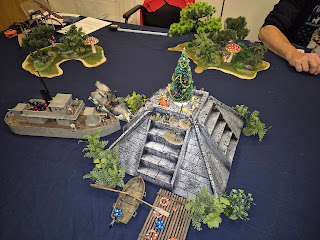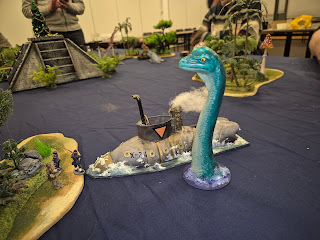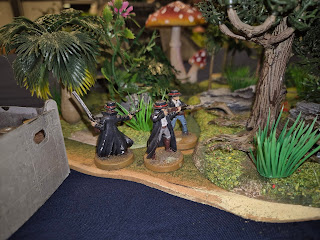As if the
Miniature Wargaming hobby wasn't complicated enough with all those periods and
rule sets, there's also the discussion about scale. Or is it the size? In any
case, there's a lot of discussion going on.
Your gaming
table usually determines the size of your figures. The more figures you want on
the table, the smaller they generally have to be.
Model
(railway) builders have scales. The most common model railway scales are 1:76
(OO), 1:148 (N) and 1:87 (HO). Model builders mainly go for 1:72 and 1:35. How
easy life would be if wargamers had chosen the same route. But no. They didn't.
 |
| 10mm, 10mm, Warlord Epic scale, 1/72 and 28mm |
Keep an
eye on the size!
Initially,
the hobby was usually played with pewter or lead figures of a certain size.
Human figures usually had a height of 54 or 15 mm. So no scale, but a
measurement.
Warriors
have put all sorts of things on their heads throughout the ages, varying from
flat skullcaps to helmet ornaments of a few feet high high. The same human
figures can therefore have all sorts of heights. Since measuring the entire
figure was not conclusive, the measurements were taken from the ground on which
they stood to the level of its eyes. Of course, that makes a 15mm figure longer
than 15mm and does not fit in a model building scale. You already guessed it:
this is British.
The
confusion was increased further by the (indeed) British model kit manufacturer
Airfix. In the sixties, they started marketing military figures in the
modelling scale OO. This of course did not fit in with the wargaming hobby
(which was nevertheless the intention). Moreover, the scale was quite small and
therefore limited in detail.
So Airfix
soon started releasing figures in modelling scale 1/72. These were slightly
larger, easier to handle and had more detail. Following the custom of wargamers
to measure their figures from the ground to the eyes, these were 20mm figures.
A new scale was born. It wouldn't be the last.
 |
| 80ies Games Workshop 28mm, N-scale, Games Workshop 28mm, 54mm Paulus Miniatires, 1/32 Italeri |
Whatever
you pay attention to will grow!
The
possibility of adding more detail to larger figures certainly did not escape
the attention of miniature manufacturers. They started making figures in the
70s with a size/eye height of about 25mm which quickly became popular. They
were cheaper than the old 54mm figures and you could fit more of them on a
gaming table.
The budding
popularity of Lord of the Rings and the Fantasy genre led to an expansion of
periods with fantasy and SciFi. The figures were used for both wargames and the
emerging Fantasy Roleplaying games and a growing number of historical and
fictional periods were added. Both the 15mm scale and the 25mm scale were
incredibly popular. Then Games Workshop came along and mass production of 25mm
figures was a fact.

The
temptation to make larger figures for more detail continued to grow. Around the
turn of the century the so-called Scale Creep Effect became undeniable: the
steady enlargement of the same figures to ensure that you can put more and
better details on them.
 |
| Pendraken 10mm, Italeri 1/32 |
This led to
the 28mm, the heroic 28mm (a thinly veiled excuse for 30mm) and the 32mm scale.
For that reason, a modern Space Marine towers over his Battlebrother from the
80s by a good head's length.
On the
other side of the spectrum, everything was also moving. For those who really
wanted to have a lot of figures on the table, figures shrank to a length of 10
mm, 6 mm and even 2 mm. This way you could literally put thousands of figures
on the table. Who didn't dream of playing with a complete Roman Legion or a
complete Panzer Division? With these figures, you could.
Size
matters
The
confusion was further increased by manufacturers who did not consistently
measure up to the eyes. And manufacturers who thought that if you release
figures in a unique scale, everyone had to buy figures from you! Because
nothing else is compatible.... And voila! The Epic scale of Warlord (12mm) was
born. By the way, not to be confused with the Epic scale of GW (6mm). Do you
still get it?
The endless
measuring and comparing of figures of different brands has become a fact of life for wargamers.
Recklessly acquiring figures in the "same" scale from multiple brands
will be done at your peril!
And don't get me started about the multitude of sizes that weapons are sculpted in, even in the same size. Do we really need a bigger gun? Or a smaller one?
Confusion is off the scale....






































.jpg)















































